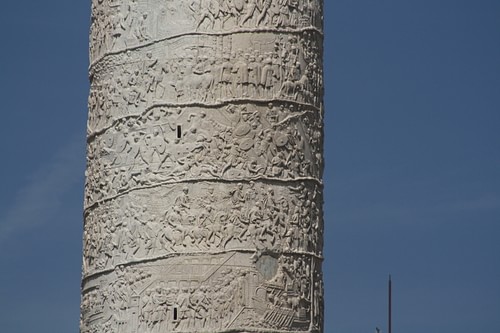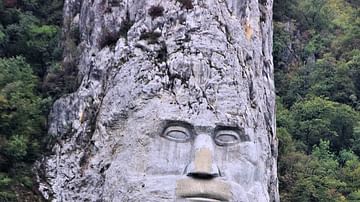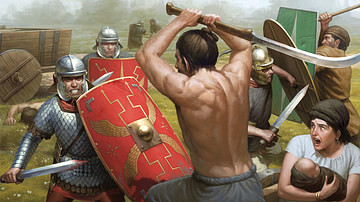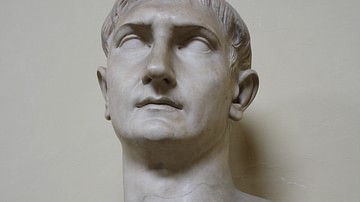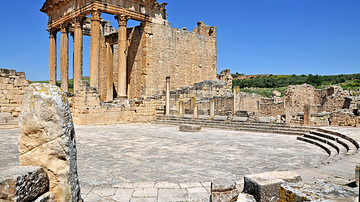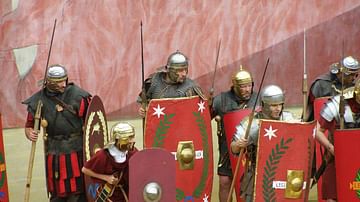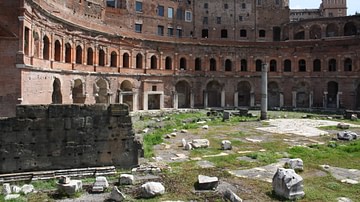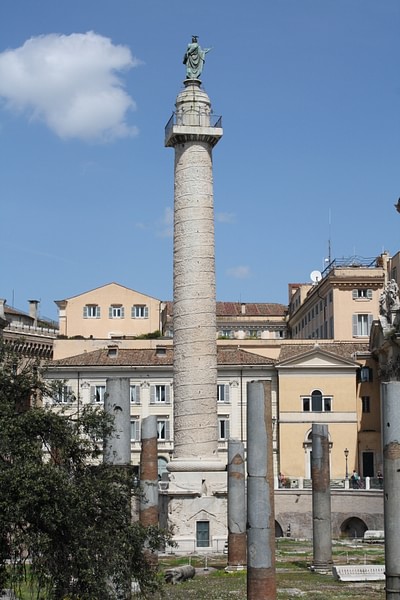
Trajan's Column, erected in 113 CE, stands in Trajan's Forum in Rome and is a commemorative monument decorated with reliefs illustrating Roman emperor Trajan's two military campaigns in Dacia (modern Romania). The column was the first of many such monuments and it is also an invaluable source of information on the Roman Army and a lasting testimony to the Roman love of monumental architecture constructed to celebrate military victories and Roman leaders.
The column stands 38 m tall (125 ft) and consists of 19 drums of Italian white marble. It stands on an 8-block base and is topped by a two-block pedestal. Originally, a 4.8 m (16 ft) bronze statue of Trajan stood on the top pedestal but this was replaced by a statue of St. Peter in 1588 CE. The column was in all likelihood conceived by Trajan's architect Apollodoros of Damascus as a commemoration of the emperor's victorious Dacian campaigns of c. 101-2 and 105-6 CE. On the Emperor's death in 117 CE his ashes were buried within the foundations of the column.
The irregular perspective and presence of over 2,600 figures carved in low relief spiralling around the column create a lively 200 m long narrative of 155 key scenes from the campaigns in Dacia with Trajan himself present in many diverse situations such as leading the army, judging prisoners, and holding councils of war. The two campaigns, starting from the base, are presented in an approximate chronology of major events and each campaign is separated by a scene with a shield and victory trophies.
Most individual scenes on the column run into each other but sometimes scenes are separated by a feature of landscape such as rocks, trees and even buildings which indicate a change of narrative scene. Figures are generally two-thirds life-size and perspective is achieved by representing scenes as though they have been tilted towards the viewer resulting in the background figures being shown above the figures in the foreground. The reliefs were originally painted in colour and traces of this survived up to the 18th century CE. Erected in the Forum of Trajan, the column's sculpture would have been much more visible from the two libraries - one Greek and the other Latin - which originally stood either side of the column.
The column stands on a pedestal which also carries relief sculpture, this time showing captured Dacian weapons and armour and four Imperial eagles carrying victory garlands. The base also has a lengthy inscription on the southeast side which uses 10cm high capital letters to indicate that the monument is dedicated in honour of Trajan by the Senate and People of Rome (SPQR) in 113 CE. The inscription also indicates that the monument was designed to show how the surrounding site had been cleared for such great works as the column itself and Trajan's Forum in general. This was achieved through the column actually serving as a viewing platform. A door in the pedestal gives access to an interior spiral staircase which climbs within the column to allow access to the top platform pedestal. The staircase is entirely carved out of the solid stone and is lit by 40 small windows set within the column at regular intervals. The viewing platform originally had a metal rail and could accommodate up to 15 people who would have admired the magnificent buildings of Rome spread out below in all directions.
The column and its spiral narrative sculpture is an invaluable source of information concerning the Roman army and reveals unique details of weapons, armour, ships, equipment, troop formations, medical treatment and logistics. The column is a tour de force of propaganda art and the artists were not necessarily concerned with accurately portraying details, nevertheless, many scenes are corroborated by other sources and much basic information must surely have conformed to the viewers' knowledge and expectations of the contemporary Roman military. In addition, the column, famous even in Roman times and also appearing on Trajan's coins, inspired similar commemorative monuments in later Roman times, the Middle Ages and even as recently as Napoleon's Vendôme column in Paris, erected in 1806 CE, which also commemorates the Emperor's military campaigns.
